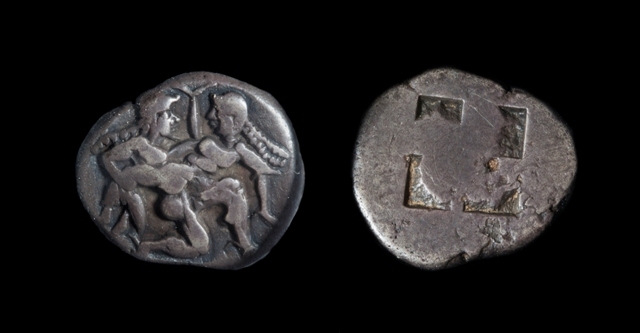Thasos, Silver Stater
Dublin Core
Title
Thasos, Silver Stater
Subject
Thasos, Greece, Silver Stater, ca. 525-463 BCE.
Obverse: Naked ithyphallic satyr running right with struggling maenad in his arms.
Reverse: Quadripartite incuse square.
Obverse: Naked ithyphallic satyr running right with struggling maenad in his arms.
Reverse: Quadripartite incuse square.
Description
The island of Thasos, just off the coast of Thrace in the north Aegean Sea, was a cultic center for the worship of Dionysus. This motif is a common one for northern Greece, an area famed for its wine.
The variations of this style include some close to absurd images where a comically muscular satyr is wooing a very muscular girl. These jolly rustic orgies are appropriate for an area where Dionysus was the most important deity and wine one of the most prized and exported products.
Satyrs, a prominent image associated with this theme, are half-goat, half man creatures with varying amounts of human/animal attributes. This coin in particular has a more man-like satyr, with the only goat-like feature being the satyr’s goat legs.
The incuse mark on the reverse side designates this coin as a very early Greek coin. The first coins were not illustrated on both sides. The quadripartite square, or four-parted square, is a mark from the hammer used to pound the silver into the obverse die.
The variations of this style include some close to absurd images where a comically muscular satyr is wooing a very muscular girl. These jolly rustic orgies are appropriate for an area where Dionysus was the most important deity and wine one of the most prized and exported products.
Satyrs, a prominent image associated with this theme, are half-goat, half man creatures with varying amounts of human/animal attributes. This coin in particular has a more man-like satyr, with the only goat-like feature being the satyr’s goat legs.
The incuse mark on the reverse side designates this coin as a very early Greek coin. The first coins were not illustrated on both sides. The quadripartite square, or four-parted square, is a mark from the hammer used to pound the silver into the obverse die.
Source
Gift of James and Aneta McIntyre, Hallie Ford Museum of Art, Salem, OR. 2006.010.004
Date
ca. 550-463 BCE
Rights
Hallie Ford Museum of Arts
Format
2.140 cm
7.800 gr
7.800 gr
Coverage
This item is on view at the Hallie Ford Museum of Art, in the Mark and Janeth Sponenburgh Gallery.
Citation
“Thasos, Silver Stater,” Hallie Ford Museum of Art Exhibits, accessed December 27, 2025, https://library.willamette.edu/hfma/omeka/items/show/55.
